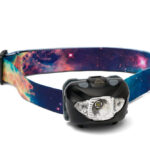While it’s common practice for alpine ascents to begin in the wee hours of the morning, most hikers describe their outings as day hikes, to end by dusk, or backpack trips, to sleep outside. This summer, consider adding a third category: the night hike.
It’s the perfect solution for long summer days, when extreme heat can take its toll on a hiker’s willingness to get outside and play. Take a cue from local wildlife by napping through the insufferable heat of mid-day, and await the cooler evenings before venturing outside.
Night Hiking Tips
There are a few special considerations before undertaking a nighttime hike—one of which is to respect local trailhead hours. A good rule of thumb is that any hike open to backpacking will also be open to night hiking, but when in doubt call the land manager to confirm trailhead access.
Local State Parks and County Parks typically close at 10 p.m. and are not open to the night hiker. Look to US Forest Service and Bureau of Land Management properties instead.
Illumination
It will also be important to check the batteries on either headlamp or flashlight, even when planning an outing to coincide with a full moon. Some of the best night hike destinations include open ridges and mountain peaks, with their unobstructed views of the night sky. Don’t forget trails along lakes, where the stars may be reflected to double the experience. However, nearly all trails leading to these views include heavily forested sections, where a little extra light will be helpful.
Consider getting a headlamp with a red light mode to maintain night vision while illuminating tripping hazards. With a smaller field of vision, and tricky footing in terrain obscured by darkness, it will be important to take it slower than a daytime hike in order to avoid a tumble. As always, have a first aid kit along for just in case.
(Find recommendations and reviews for headlamps and other hiking gear in the OTO archives.)
Navigation
Navigation can also be trickier in the darkness. It might be easy to miss trail signs, which are typically not reflective, or accidently hike past unmarked trail junctions. Have a map and compass, along with an electronic backup like a GPS unit. Let someone at home know where you intend to be, and when you intend to return.
Clothes & Snacks
Don’t forget a warm layer for rest breaks, since nighttime temperatures will be vastly different from daytime highs. It will also be important to pack a larger-than-usual midnight snack, which will basically serve as a second lunch. Despite the cooler temperatures, staying hydrated will be crucial as well. Carry enough water for the entire hike, or pack a method of treating water along the way.
Pre-Trip Planning
Finally, do a little research leading up to a night excursion. Aside from checking weather reports to ensure starry skies, it’s worth looking into astronomical events. Some hikers prefer the extra light afforded by a full moon. Do an online search for full moon dates for your location. (Here is a website that provides current dates for Spokane.)
For a better view of the stars, look instead for the new moon. And learn the dates for the summertime Delta Aquariid meteor shower (July-August) and Perseid meteor shower (August), which may even coincide with a new moon.
Originally published “When the Sun Goes Down? Take an Enchanting Night Hike” in the June 2018 print issue.
For night hike location suggestions see “Where To Go Night Hiking in the Inland Northwest.”
[Updated: June 2021]














